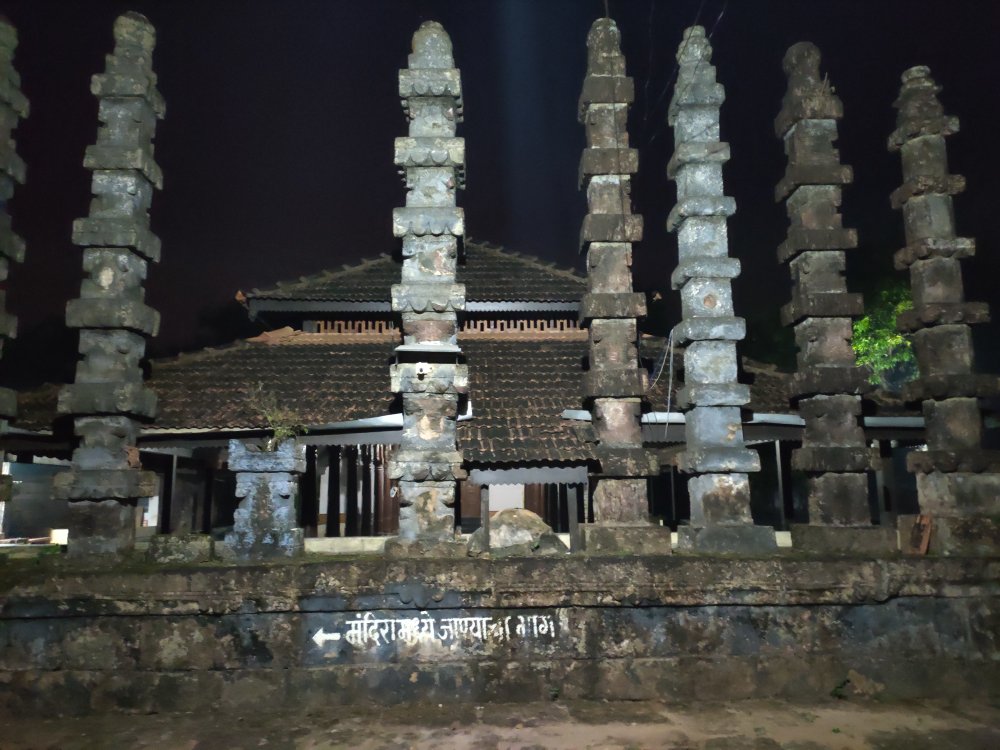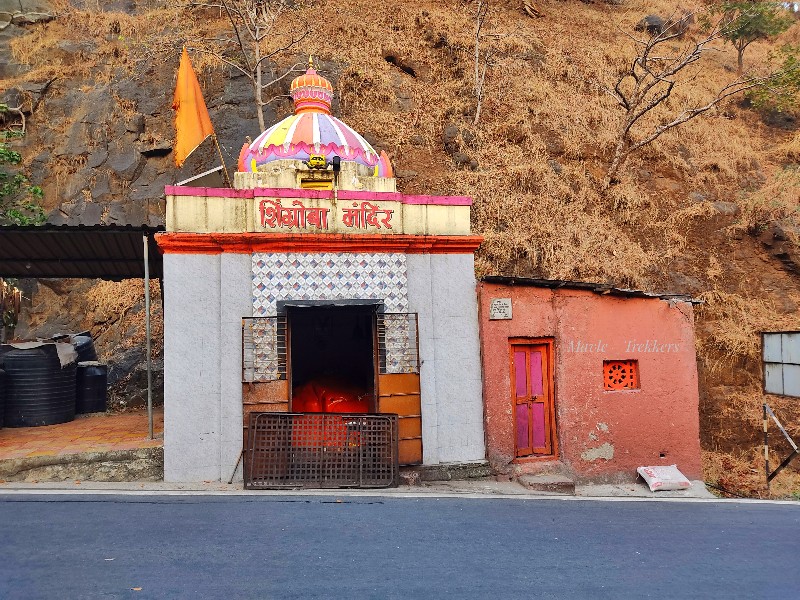द्रोणागिरी – Dronagiri Temple, tala, Raigad
Table of Contents

History behind the Dronagiri Temple :
Dronagiri Temple is situated in the top of the Dense forest of the mountains. Base village is a Malathe Village, Taluka Tala, district Raigad.Dronagiri Temple is situated in the top of the Dense forest of the mountains. Base village is a Malathe Village, Taluka Tala, district Raigad.
This is secluded and calm spot for the tourists who want peace of mind. Dronagiri is a religious place for the Dhangar community and nearby villagers. Dronagiri is also known as “Devacha Dongar”. In the month of April villagers nearby are celebrating religious rituals called “Jatra”.
The legend story of Donoba is as follows. A millennium ago, two brothers and dodoba and vanoba, who descend on the coast of Rahathad, go to see. The fishermen help them to get off the sea, we can still see the idol of donoba at the Rahatad Harbor. Later, while traveling, there was a meeting with the Mhasoba Rakwaldar at the village of Rahatdwadi, Mhasoba kept the two men next door, so that they fought the Tablal war, in the end, the donoba with his sword made two parts straight of Mhasoba, that carvardi (Mhasoba Nali) is still a statue, and it appears to have two equal parts, the old knowers still provide this information.
Later, both of the brothers move forward, after going to the hill, after going to the place of their two brothers, Vanoba, they go ahead to see their place in a suitable place for their permanent reality, going up the mountain and searching for a place. The place is very well ventilated and trees are shrubs. Vanoba is tired as he climbed the mountain, so he drinks the cold water from a running stream and falls asleep.
The donoba is worried about waiting for their younger brother, and he start riding on his white horse and going to Vanoba. After reaching to vannoba , he was shocked ! As his younger brother has gone to bed deep and both of them are angry with his behavior and pushed Vannoba in the rage with anger, if you still go to that place, you can see Vannoba in stone in the valley.
The villager from Tarne village used to take his cows to feed on to the mountains, and one of his cows was lame. In the afternoon, the cow went for a pasture to feed in the forest, not giving milk at night, the villager was worried, the cow gives good milk in the morning and then why does it happen at night? One day, after follows the cows, and he was wondered to see the cow was offering her milk on a bush of Carissa spinarum (Karvanda chi jali), he would have been running for several days.
One day, the villager toke 3-4 people from village to check the bushes, confirming this, self-idols are found there and this story spreads far away. Next, people from surrounding villages come together and build a small house, the owner of the cow which gave milk in the bush is honored with the seat to high position during the Jatra, honor is present till now and the koli’s which helped Donoba and Vanoba are given the honor to be priests of the Donona temple, and the priest in the temple of Padmavati Devi this honor went to Malathe village.
In the coming days, the celebration of Jatra became famous all around, large numbers of people started joining in, and the faith of the people from the surrounding villages increased to two-fold, vow was started, people’s wishes began to be fulfilled. The tradition of taking the SansKathi from the surrounding villages is going on till date. Even today, it is very crowded, even though there are no traffic facilities, people are attracted to the mountain and are regularly seen every year, even if the body is tired by climbing the hills, the mind is pleased after going there. Tiredness vanishes as soon as you see the green vegetation, pleasant surroundings, pleasant atmosphere and drink the cold water from the temple, as the story of Shri Donoba gramdevat goes on and on.
The above information is awaited, there may be a slight difference, but it is our trust and faith that Shri Dayanoba is our place of worship. This is part of the story, but let’s think about the geographical situation, this part is on the top of the hill and there are tall high mountains on all sides and the forest is also quite good. Both of them are standing in the mouth of a waterfall falling under rainy season, out of which the temple of Padmavati is situated on the upper side (Both the wives of the goddess are in different temples, just like Pandharpur remember?.) There are many statues of Goddess idols in the Goddess, and they are well-preserved and incomparable. Shri Donoba’s idol is standing beside the wall of his temple, his idol is said to be self-idol, there is a deep valley at the backs of the temple, the temple is completely peaceful and tiny.
In Dobaoba temple people come from miles away to vow and repay the fulfilled vows, there is a stone lamp, there are big and ancient trees of mangoes in this area, their shade spreads around the entire temple area, there is an old water tank, it is now constructed by the cement concrete, so that water is available throughout the year. From here, women of Dhangarwadi are still taking water for domestic use and now the electronic power facility has been made, there are few solar panels for basic electric use in temples, the traders in from Tala .Taluka come to trade on the day of jatra and sell various food and entertainment products.
Nowadays the entertainment devices are increased and not like the old days when people used to communicate and celebrate festivals together, as a result this place not that crowded as it used to be once. historic information is not available, If you want to get it, you will have to go through the old government offices or search in the Colaba district’s gadget. If you get that information, then it can also be understood that the Jatra is started from Peshwa era or from British era. But there will be a lot of documents for this and the attitude of research should be there in that person and it can be understood from the fact that the history of the Shri Donnoba‘s Jatra is very ancient.
-
What to see :-
1). Temple
2). Rahat
3). Waterfall
-
Ways to Reach :-
Approx 165 KM from Mumbai
1). Via Roha (with Ghosala Fort) –
Mumbai Goa Highway – Right for Nagothane – Roha – Roha Tala Road – Malathe Village
2). Via Indapur Tala (with Tala Fort) :-
Mumbai Goa Highway – Indapur – Tala Road – Tala Rowla Road – Take right for Rahtad Village Road – Take Right on Dirtroad towards Dronagiri
3). From Murud (with Murud Beach and Kuda Caves) :-
(a). Murud – Bhalgav – go straight for Roha Road – Malathe Village
(b). Murud – Bhalgav – (via Kuda Caves) – Tala Road – Rahtad.
-
By Public Transport :-
Near Railway station is Roha and Mangaon.
Near ST Stand – Tala ST Stand (Nearest), Indapur ST Stand on Goa Highway, Roha ST Stand.
From Indapur there are available Share Rickshaws for Tala and from Tala there are also available Share Rickshaws for Mandad, Rowla, Pitsai. get down at Shenavali Village (Rahtad Fata). Take right towards dirtroad for Dronagiri.
-
Nearby Spots :-
1). Tala Fort
2). Ghosalgad Fort
3). Kuda Caves
4). Murud Beach
-
For Lunch & Hotel :-
1). Tala
2). Indapur
3). For snacks on the Tala Roha Road near Pitsai Village Stop.




Pingback: Ghosalgad Fort - घोसाळगड - Mavle Trekkers